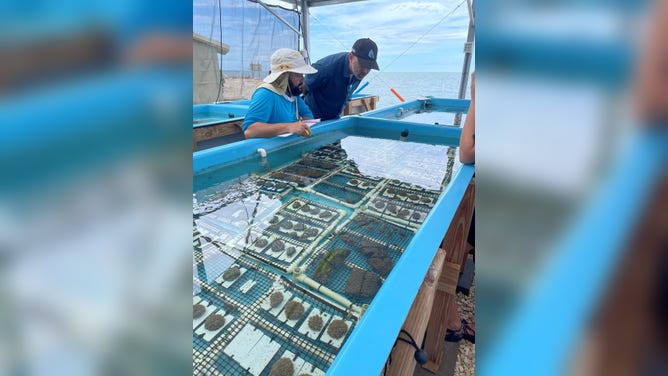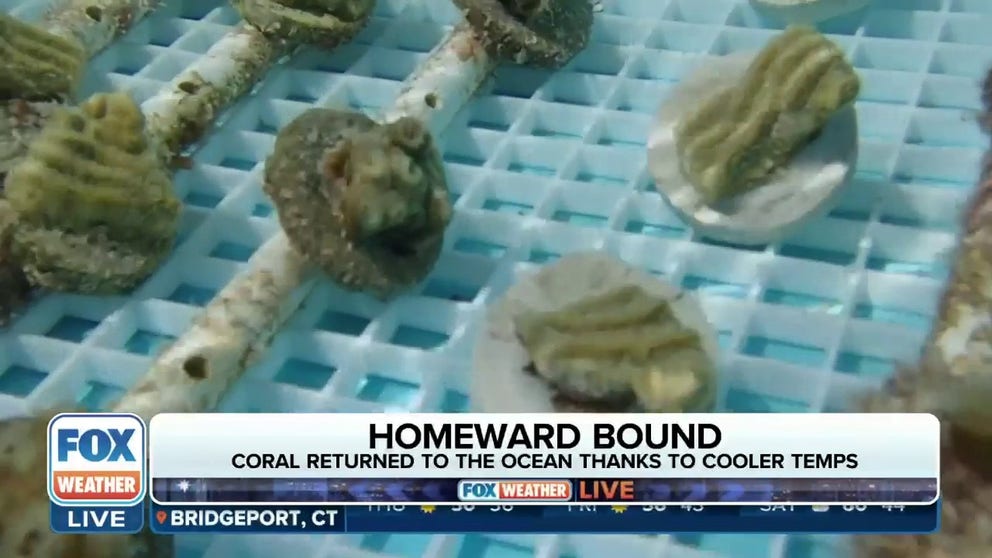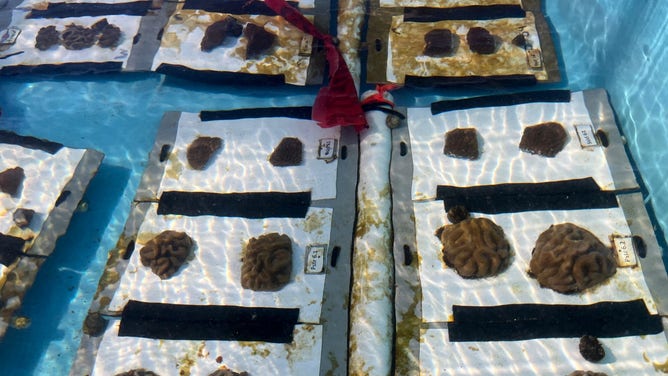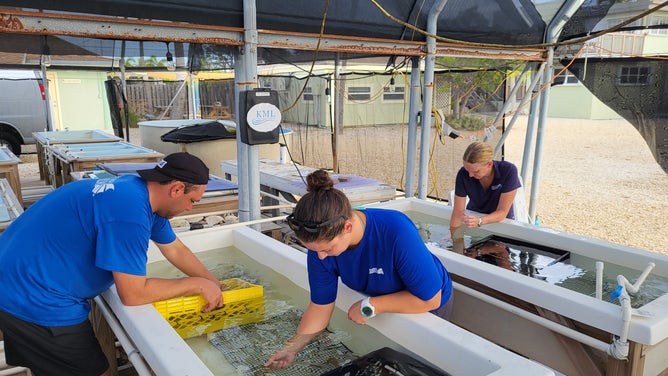After 'first of its kind' marine heat wave, Florida corals begin return to ocean
During the hottest summer in the Key Marine Laboratory’s history, the electric bill was $4,000 a month as the lab kept thousands of corals safe after being rescued from a mass bleaching event.
Florida corals making a comeback after ocean heat wave
Cynthia Lewis, Director of Keys Marine Laboratory, explained to FOX Weather how her lab attempted to rescue coral from record summer water heat. Hurricane Idalia helped to remedy the temperature spike and some of the corals are making it back to sea.
LONG KEY, Fla. – Coral biologists are beginning the multistep process of returning thousands of coral pieces to the ocean off Florida’s coast after being housed in onshore tanks during this summer’s historic marine heat wave.
Scientists in the coral community said the El Niño-fueled marine heat wave that sent sea surface temperatures around Florida to well above the bleaching threshold for coral was unprecedented. The bleaching event tested resources across Florida as biologists and volunteers raced for months to save corals and keep them healthy.
"This is a first of its kind, but unfortunately, it's probably going to be repeated," said Cynthia Lewis, director of the Keys Marine Laboratory.
Sea surface temperatures around South Florida and the Keys reached the 90s in June, even topping out at 101.1 degrees in the Florida Everglades. For Florida reefs, when the water temperatures reached 86.9 degrees, the tiny algae coral rely on for food began to die from heat stress. The coral then expelled them in a process called bleaching.
The temperatures remained at bleaching levels until September, according to NOAA's Coral Reef Watch. Previous Florida coral bleaching events didn't start until August.
"This is the first time we've ever seen something of this scope, this magnitude, and for this long," Lewis said.
Noah’s Ark for corals
Normally, the University of South Florida and Florida Institute of Oceanography’s Keys Marine Laboratory hosts between 100 and 300 corals monthly.
In July, lab partner organizations worked to relocate coral to the controlled marine laboratory as the mass bleaching event continued throughout the summer. By late August, KML had taken in about 5,000 pieces of coral. Among those brought in were several endangered Florida corals, including Staghorn and Elkhorn.
HOW CARIBBEAN KING CRABS ARE RESCUING CORAL REEFS IN FLORIDA
"Within two weeks of the whole thing starting, we had close to 100% of our tanks and tables full of coral," Lewis said.
The lab has three staff biologists who maintained the corals, sometimes seven days a week. They also hosted boat trips with classes and other on-site research groups.
"It’s been exhausting," Lewis said.
A crucial part of keeping the corals at KML safe is the water temperature in the tanks, a significant challenge during the hottest summer in the lab’s history, according to Lewis. The facility's electric bill was $4,000 a month during the peak of summer.
"Our air temperatures here at the lab were 92, 94 degrees with a 115-degree heat index almost every day all through August and, you know, July, August into September," Lewis recalled. "And we were trying to keep water temperatures in our seawater system at 85."
JULY WAS WORLD'S HOTTEST MONTH ON RECORD, SCIENTISTS SAY
KML has backup generators to keep the tanks cool during a power outage. When Hurricane Idalia approached the peninsula, Lewis contacted Monroe County emergency management for a "backup to the backup." The county quickly mobilized a generator, fuel and a technician on standby for the laboratory in case it was needed.
"When I asked them, ‘What can I do for you?’ And they said, ‘Just keep the corals. Just keep the corals alive,’" Lewis said of county officials "That's all they wanted."
Happy corals
Lewis said things settled down after the first month, and then it became about keeping the corals happy while also helping the KML restoration partners.

Coral Health Veterinarian Dr. Ari Fustukjian assessing coral health at the Keys Marine Laboratory facility. (Image credit: FIO)
"A lot of the partners that are restoration partners, they can take care of corals out in their nurseries till the cows come home. But they've never had to handle coral in captivity, in tables for three and four months," Lewis said. "It was a steep learning curve to learn what each coral likes. Every species of coral has its definite likes and dislikes."
One of those partners, the Coral Restoration Foundation, is beginning to return its corals from the lab back to ocean nurseries. About 10% of CRF's corals were brought to onshore tanks during the bleaching event. The Foundation said about 1,317 rescued coral colonies recovered from heat stress and survived at KML and the Sea Base.
Water temperatures have stayed below the bleaching threshold for several weeks, allowing the return process to begin in early November. The cooler temperatures are partly thanks to Hurricane Idalia stirring up the water around Florida.
Before corals, which are animals, can be returned to the ocean, they need a vet check-up. The corals are closely examined for any potential disease that could spread on the reef. Lewis said a coral health veterinarian will look at every single table of corals before they are given the OK to return to sea.

Coral Health Veterinarian Dr. Ari Fustukjian assessing coral health at the Keys Marine Laboratory facility. (Image credit: FIO)
"It's not going to be done in a single day. It's going to take several days, several weeks," Lewis explained. "Some of the corals that they thought, ‘Eh, they need a few more weeks to get right with themselves and get strong enough.’ They're going to be re-inspected again."
All the corals staying at KML came from ocean coral nurseries. The corals will be placed back out on "trees" growing corals for at least 30 days before being considered for planting on a wild reef.
Coral biologists will continue to watch for disease out on the reefs. Historically, bleaching events last multiple years and disease has followed, causing more coral fatalities.
Next spring and summer, the coral community in Florida is braced for the next bleaching event as the El Niño climate pattern is forecast to continue into the winter.
Regardless of when it happens, Lewis said the Keys Marine Laboratory and its partners are better prepared for next time because of what they learned this summer.







